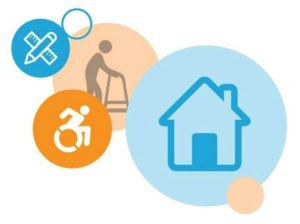Survey reveals essential accessible design features based on lived experience of people with mobility impairments
A new study by La Trobe University and the Summer Foundation investigates the most important design features to make homes more accessible. 1 It provides evidence to support national implementation of accessibility standards in the National Construction Code (NCC). It provides results from a survey of 145 people with mobility impairments revealing the most essential features, as well as why they are important.
What is the problem?
Demand for accessible housing in Australia is growing, due to an ageing population. By 2060, over 5 million Australians will have a mobility impairment. 2 Despite this demand, there is a national undersupply of accessible housing. State and federal governments acknowledge the supply and demand imbalance, and in 2011 introduced targets to boost the amount of accessible housing stock. This voluntary program was not successful, as less than 10% of new houses met accessible design standards by 2020.
In response, in early 2021 Australia’s building ministers agreed to include minimum accessibility standards in the NCC. 3 This regulatory approach will mandate that all new houses must include several accessible design features as a minimum requirement. However, not all states and territories have agreed to implement these standards, which will lead to an unequal supply of accessible housing across Australia. Evidence is needed to inform decision makers on the impact of accessible housing on the lives of people with mobility impairments. Only national implementation of the NCC will address the undersupply of accessible housing.
What are the main findings?
In total, 145 people with a mobility impairment (or a carer) completed the survey. This included people with disability and the elderly. Of these, 71% stated that they were living in housing that did not fully meet their accessibility needs. Participants were asked to identify design features that they would change in their own homes and the homes of their friends and family to make them more accessible. The most reported changes were:
- Step-free entrance to the home
- Wider internal doors and corridors
- Level access throughout the home
- Increased bathroom space
Participants were also asked why these changes were important to them, which revealed 3 key positive impacts associated with accessible design features.
Impact 1: Increased social inclusion
Accessible housing design promotes social inclusion, as people with mobility impairment are freer to move around their own homes, and those of others. For some people, getting into the houses of family and friends was either impossible or extremely difficult. Participants noted that if the effort of visiting someone at home was too great, they were less likely to visit again.
Impact 2: Increased functioning & independence
Accessible design features in homes enable increased functioning and independence in completing everyday tasks, such as accessing storage and kitchen cupboards. The effort of navigating inaccessible homes significantly impacted participants’ lives. However, accessible features improve mobility and assist ease of movement, such that energy could be saved for more meaningful tasks. A home with accessible features also reduces the risk of trips and falls, as well as allowing quick and safe egress from the home in the event of an emergency.
Impact 3: Increased quality of life
Accessible design was often reported to result in significant changes to quality of life. For some, accessing outdoor areas could improve mental wellbeing, increase areas for socialising around the home, and allow hobbies such as gardening to be undertaken. Accessibility could also allow people to choose where they spend their time within a house, as well as the freedom to safely age at home.
What are the policy implications?
Despite the inclusion of accessibility standards in the 2022 NCC, New South Wales, South Australia, and Western Australia have not agreed to their implementation. This survey obtained the lived experience perspective of people with a mobility impairment – a perspective often lacking in policy development. Their insights are key evidence that can be used to inform state and territory decision makers on the need to implement minimum accessibility standards. As such, this study serves as the basis for further investigation as part of wider consultation on the roll-out of the 2022 NCC.
Notes
- Goodwin et al. (2021). ‘Making homes more accessible for people with mobility impairment: A lived experience perspective.’ DOI: https://onlinelibrary.wiley.com/doi/full/10.1002/ajs4.214
- CIS (2020). ‘Consultation RIS: Proposal to include minimum accessibility standards for housing in the NCC.’ https://consultation.abcb.gov.au/engagement/consult-ri s-accessible-housing/
- (2021). ‘Building Ministers’ Meeting: Communiqué April 2021.’ https://www.industry.gov.au/news/building-ministers-meeting-communique-april-2021

